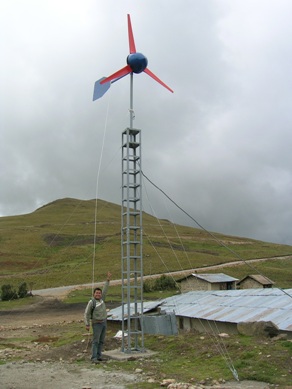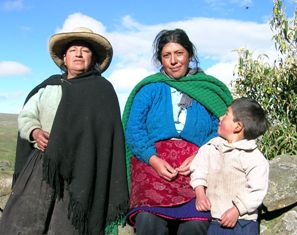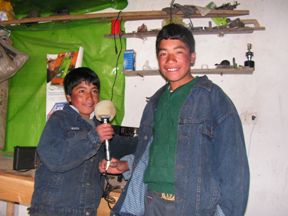Wind Power Blows into Peru and Brightens Future
June 17, 2008 - EcoWordly
Written by Levi Novey
 (left) 500-Watt Wind Turbine in Alumbre, Peru
(left) 500-Watt Wind Turbine in Alumbre, Peru
Not too many years from now, parents living in the little town of Alumbre, Peru will probably tell their young children that they remember the days before there was electricity. These "old-timers" will talk about how wind was once thought of as the enemy– blowing out the few candles that provided light as they struggled to finish their homework after dark, or while trying to finish weaving a sweater. The kids, like most, will probably shrug off these anecdotes of wisdom from the past, wondering how their parents could ever think of something as wonderful as wind as an enemy.
Why Wind Power Might be a Perfect Fit for Many Communities in Peru
Last year, a collaborative project was undertaken by several organizations to bring wind power to a small village in Peru. It was designed as a practical experiment to understand whether or not using small wind turbines might provide for an efficient, cost-efficient means to provide electricity to communities without electricity in rural areas of Peru. Approximately 70% of Peru's rural communities lack electricity, according to Green Empowerment, an American non-profit organization that worked with Soluciones Prácticas (Practical Action) to implement the project. Many of these places are inaccessible to traditional means of obtaining electricity, and for this reason — wind — a free natural resource, might provide an excellent solution for helping to power some of these communities.
Alumbre, Peru with a population of around 132 people presented itself as an excellent place to test out the idea that wind power could help bring electricity to many new places in Peru. Anna Garwood, who is the Latin America Project Manager for Green Empowerment, explains that "Alumbre is located at about 3800 meters above sea level (~ 12500 feet). It's above the tree line, and so there's really little vegetation and a lot of wind."
The Wind Turbines in Alumbre Provide Electricity for Homes, a School, Cell Phone Charging, and Even a Radio Station
To say that this experimental project has been a success so far would be an understatement. Last year 21 homes in Alumbre were equipped with 100-watt wind turbines that power their homes, and the village's school was powered with a 500-watt turbine. The wind turbines store energy into what are known as "deep cycle" batteries, and the batteries when fully charged can potentially provide energy to homes for up to three days. The batteries need to be replaced every 3-4 years, and for this reason each family with a turbine must contribute to a battery replacement fund on a monthly basis. They pay about 10 nuevo soles each (~ $3 American), a sum that's less than what most families were previously spending each month on candles and kerosene for lamps.Citizens of Alumbre, Peru
 (left) Citizens of Alumbre, Peru.
(left) Citizens of Alumbre, Peru.
In addition to school age children being able to do their homework more reliably at night, people are finding activities like sewing, carpentry, and traditional weaving to be easier at night with electricity as well. One more additional benefit is that there is less smoke in their houses from candles and kerosene lamps, which is associated with eye and respiratory health issues.
The town's school also now has lights, and can power two computers, as well as a television and DVD player for educational videos on everything from algebra to history. The wind systems also charge cellular phones. "One exciting and unexpected result is that now people from nearby communities are walking to Alumbre, and paying a small fee to charge their cellular phones. So the wind turbines have really improved peoples' ability to communicate with the outside world," says Garwood.
In fact, one very creative family decided to use some of their wind energy to set up a small radio station. The station has a range of about 50 kilometers (~ 30 miles) and broadcasts music and announcements. It is another way that by harnessing the power of the wind, the ability to communicate over long distances has become easier in this remote area of Peru.
 So What Happens If the Wind
Turbines Break? Who Fixes Them?
So What Happens If the Wind
Turbines Break? Who Fixes Them?
(right) Alumbre Peru\'s Most Popular Radio Hosts
One important aspect of Green Empowerment's mission is not only to help provide clean, alternative energy to communities in need, but to also provide those communities with the capacity to solve problems and partner with other organizations so that they are empowered in the future. In Alumbre, this empowerment and capacity building was facilitated in three key ways.
As the wind turbines were installed, a group of 8 interested individuals in the community were provided with training to repair and maintain the wind turbines. They also received training in the business and technical aspects of operating the community's new electrical system. Once the wind power system was functional, the individuals all took a written test to assess their knowledge of the operation. In combination with this test, the community leaders selected who they thought had shown the most interest and effort in helping with the project, and had good standing in the community in general. Once an individual was selected to serve as the principal facilitator of the wind operation, he was given a uniform and helmet. In the words of Anna Garwood, this helps "to put forth a professional image and show that this venture is on par with any other electrical company." The previously mentioned monthly tariffs feed a fund for maintenance and battery replacement as well as financial support for the micro-business operator for his ongoing work on the project.
The second way that the project team ensured that Alumbre was empowered, was by selecting locally-made appropriate technology. Soluciones Prácticas-ITDG, who had been working since 1998 to build locally-made small wind turbines, designed the technology for the Alumbre wind power system. They then taught a small Peruvian company how to fabricate the turbines. All of the materials they use can be found locally with ease, making it much easier to replace and repair the turbines if necessary at a low cost. Soluciones Prácticas eventually discovered that the best material to use for the blades of wind turbine was fiberglass. Garwood expains that "the weight, durability, and ability to form a material at the right angles all make a difference in how efficiently the blades will work on a wind turbine."
The final way that Green Empowerment and Soluciones Prácticas attempt to ensure success in Alumbre is by understanding how the community is responding to their newly acquired wind power, and by attempting to understand the changes it will create in the fabric of the community over time. Soluciones Prácticas' sociologists and engineers spent months working closely with the community from project conception to installation, management, and follow-up. By having this information, it will allow the project team to better understand if people in Alumbre are supporting the project appropriately and contributing to its success. It might also help determine which factors are important for ensuring a community's support– a key element for making the decision to implement similar wind power system projects in other Peruvian communities. This social science aspect of the project is ongoing, as is the installation of more wind turbines in Alumbre.
What the Future Holds for Alumbre and Peru, and How You Can Get Involved
Next month, 14 additional 100-watt turbines will be installed in Alumbre. The houses with children in Alumbre were prioritized, and were those that were provided with wind power last year. An additional 500-watt turbine will also be installed later this year to power lights for the town's medical clinic. It also will provide enough energy so that a refrigerator can be used to store important medical supplies like vaccines.
 (left) A
100-Watt Turbine in Alumbre, Peru
(left) A
100-Watt Turbine in Alumbre, Peru
Green Empowerment and Soluciones Prácticas have implemented many other projects in Peru. These projects have involved installing solar power and micro hydro systems in others communities, as these forms of alternative energy seemed more feasible and practical in those places. More projects will undoubtedly occur if success levels are high with these projects, and also the wind power project in Alumbre.
What is perhaps the most impressive thing of all about the wind power project in Alumbre is that it only cost $47647 to buy all of the equipment for the project. In the grand scheme of things, that really does not seem like a whole lot of money. To raise the money, Green Empowerment, Soluciones Prácticas, la Universidad de Cataluya, and Ingeneria Sin Fronteras worked together to fund the project and raise money from other organizations like Wisions. Green Empowerment also held a fundraiser at a Peruvian restaurant called Andina in Portland, Oregon, in addition to receiving donations from private individuals.
If you think that the work of Green Empowerment is something that you would like to be involved with, they do have some volunteer opportunities available (usually a three month commitment is required). You can also donate money to support their efforts and projects, which are happening in many other countries around the world in addition to Peru. For more information, please click here to visit their website.
It's rare to come across a conservation project that is as inspirational as this one. Perhaps the next time you feel a bone-chilling, winter gust of wind piercing through your coat as you walk outside, you can take comfort in your knowledge that somewhere in Peru, up at 12,500 feet, there are people enjoying and benefiting from the clean electricity that strong winds provide. Maybe if you have kids, you'll even choose to tell them about it. Who knows, they might even appreciate it some day.